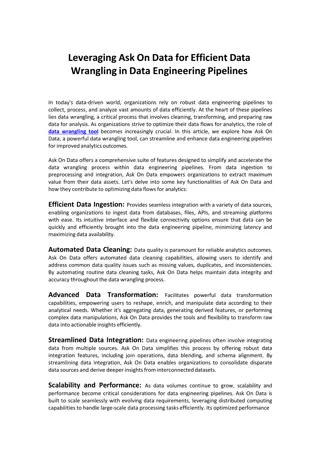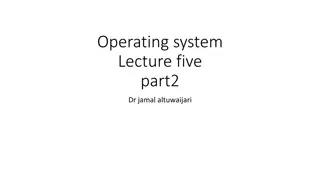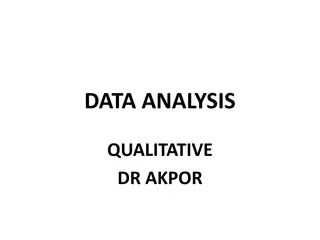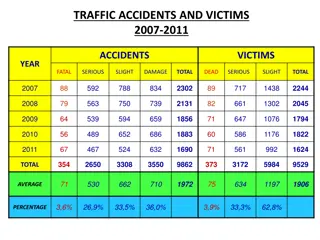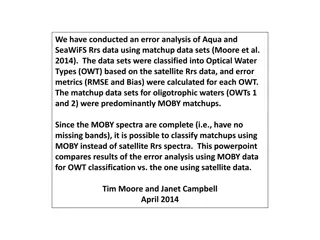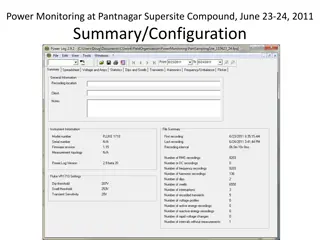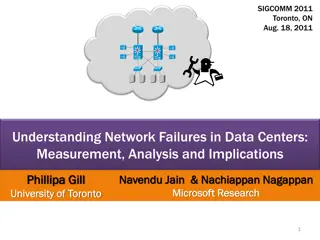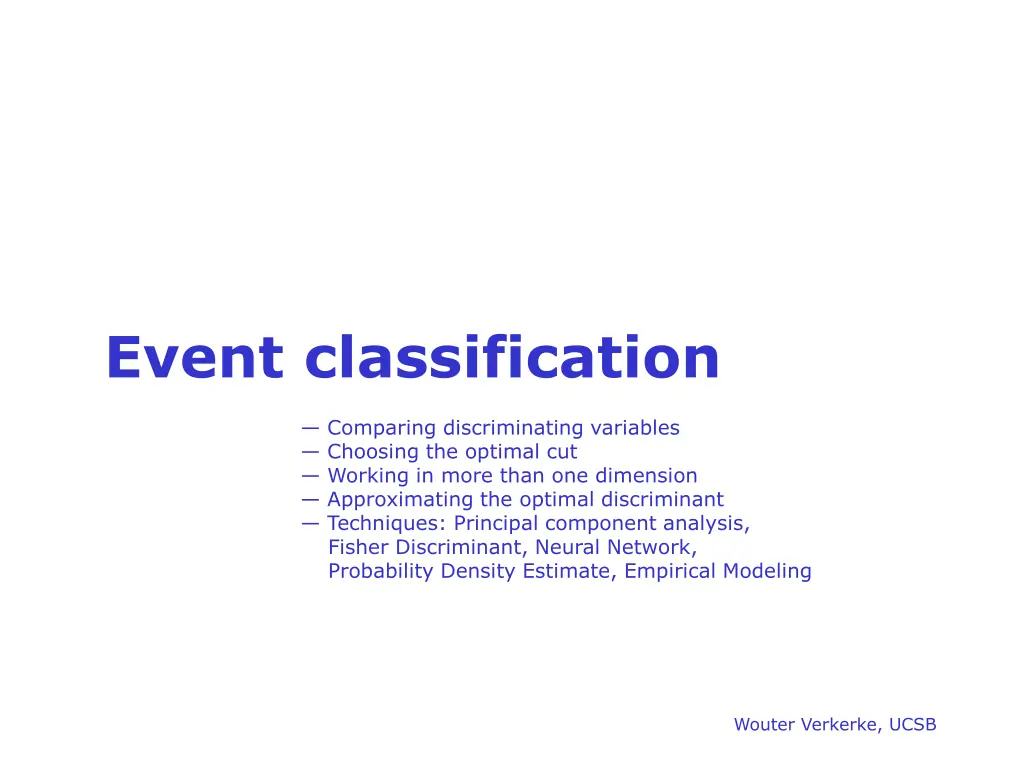
Optimal Techniques for Event Classification in High Energy Physics Analysis
Delve into the complexities of event classification in High Energy Physics analysis, exploring discriminating variables, optimal cut selection, and various techniques like Principal Component Analysis, Fisher Discriminant, Neural Networks, Probability Density Estimation, and Empirical Modeling. Learn about statistical approaches, multivariate classification challenges, and the merits of different strategies to achieve the best statistical sensitivity and measurement error reduction in event classification tasks.
Uploaded on | 1 Views
Download Presentation

Please find below an Image/Link to download the presentation.
The content on the website is provided AS IS for your information and personal use only. It may not be sold, licensed, or shared on other websites without obtaining consent from the author. If you encounter any issues during the download, it is possible that the publisher has removed the file from their server.
You are allowed to download the files provided on this website for personal or commercial use, subject to the condition that they are used lawfully. All files are the property of their respective owners.
The content on the website is provided AS IS for your information and personal use only. It may not be sold, licensed, or shared on other websites without obtaining consent from the author.
E N D
Presentation Transcript
Event classification Comparing discriminating variables Choosing the optimal cut Working in more than one dimension Approximating the optimal discriminant Techniques: Principal component analysis, Fisher Discriminant, Neural Network, Probability Density Estimate, Empirical Modeling Wouter Verkerke, UCSB
Introduction to event classification Most HEP analysis involve classification of events in signal and background Statistics connection : Hypothesis testing Determine consistency of each event with a signal and background hypothesis No certain answer on signal-vs-background classification for each event, but rather a probability P(sig)=50% Signal Signal hypothesis Gaussian distribution in x Background P(sig)=0% Background hypothesis Flat distribution in x In simple cases like above example no need to make cut on signal probability Go straight to parameter estimation: what is # of signal events?
Multivariate event classification Many HEP problem are much more difficult than preceding example Many observables, overwhelming background. Various approaches possible Analyses perform various combination of two techniques Selection of events (throw out events that are not very much signal-like) Parameter estimation (assign signal probability to each event determine total number of signal events in sample) Cut and count (or fit) First make preselection of events that are most signal-like Then do parameter estimation or simple counting on those events Compactification Compactify information in multiple observables into one observable (e.g. output of neural network) test statistic t(x) Do parameter estimation on compactify representation Big fit Make explicit model of signal and background hypothesis in all observables and fit all data to estimate model parameters (#signal events, Higgs mass etc ) Wouter Verkerke, NIKHEF
Merits of various approaches Statistical sensitivity Cutting usually throws away some information. Compactification can loose some information, but not necessarily Big fit keeps all information Feasibility Cutting usually easiest Compactification. Recent developments in machine learning make this a lot easier Big fit clearly most ambitious What is the best you can do? Best (this context): Smallest stat. error on measurement Equivalent statement for a selection cut: lowest possible bkg. efficiency at a given sig. efficiency
Hypothesis testing Introduce some terminology of hypothesis testing Assumed one has a model for data under two hypotheses Null hypothesis (H0) = Background only Alternate hypotheses (H1) = e.g. Signal + Background One makes a measurement and then need to decide to accept or reject H0 Wouter Verkerke, NIKHEF
Hypothesis testing Definition of terms Rate of type-I error = Rate of type-II error = Power of test is 1- Treat hypotheses asymmetrically Null hypo is special Fix rate of type-I error Now can define a well stated goal Maximize the power of test (minimized rate of type-II error) for given Wouter Verkerke, NIKHEF
The Neyman-Pearson lemma In 1932-1938 Neyman and Pearson developed in which one must consider competing hypotheses Null hypothesis (H0) = Background only Alternate hypotheses (H1) = e.g. Signal + Background The region W that minimizes the rate of the type-II error (not reporting true discovery) is a contour of the Likelihood Ratio Any other region of the same size will have less power Wouter Verkerke, NIKHEF
What is the best you can do? Neyman-Pearson lemma: For a problem described by a continuous signal distribution f(x|s) and a continuous bkg distribution f(x|b) the optimal acceptance region is defined by Note that for continuous distributions you cannot always achieve perfect separation Translation for 3 approaches Cut and count: Optimal cut is defined by surface S(x)/B(x)> Compactification: Optimal 1-D test statistics t(x) = S(x)/B(x) Big fit: Optimal fit is when model M(x)=NS S(x) +NB B(x) Wouter Verkerke, NIKHEF
Why Neyman-Pearson doesnt always help The problem is that we usually don t have explicit formulae for the pdfs Instead we may have Monte Carlo models for signal and background processes, so we can produce simulated data, and enter each event into an n-dimensional histogram. Use e.g. M bins for each of the n dimensions, total of Mn cells. But n is potentially large prohibitively large number of cells to populate with Monte Carlo data. Compromise: make Ansatz for form of test statistic with fewer parameters; determine them (e.g. using MC) to give best discrimination between signal and background. Wouter Verkerke, NIKHEF
Using test statistics to describe the selection (x ) t All decision boundaries ( cuts ) can be expressed as where t(x) is a test statistic and is a parameter Goal is a test statistic as close as possible to t(x)=S(x)/D(x) Rectangular cut Linear cut Non-linear cut H1 H1 H1 H0 H0 H0 accept accept accept = + = ( ) t x a x a x = + + ( ) ( ) ( ) t x x c x c ( ) ... t x a x x A x j j i i j j i i Two separate questions What is the optimal form of t(x) Independent of ratio Nsig/Nbkg What is the best value of Depends on ratio Nsig/Nbkg
Constructing test statistics Linear discriminants A linear discriminant constructs t(x) from a linear combination of the variables xi N = =1 H1 = ( ) t x a x a x i i H0 i accept Optimize discriminant by chosing ai to maximize separation between signal and background Most common form of the linear discriminant is the Fisher discriminant a ( ) T R.A. Fisher Ann. Eugen. 7(1936) 179. = 1 ( ) F x V x S B Inverse of variance matrix of signal/background (assumed to be the same) Mean values in xi for sig,bkg Wouter Verkerke, UCSB
Ansatz test statistics The Fisher discriminant a ( ) T R.A. Fisher Ann. Eugen. 7(1936) 179. = 1 ( ) F x V x S B Inverse of variance matrix of signal/background (assumed to be the same) Mean values in xi for sig,bkg Advantage of Fisher Discriminant: Ingredients s, b,V can all be calculated directly from data or simulation samples. No training or tuning Disadvantages of Fisher Discriminant Fisher discriminant only exploits difference in means. If signal and background have different variance, this information is not used. Wouter Verkerke, UCSB
Example of Fisher discriminant The CLEO Fisher discriminant Goal: distinguish between e+e- Y4s bb and uu,dd,ss,cc Method: Measure energy flow in 9 concentric cones around direction of B candidate Energy flow in u,d,s,c Energy flow in bb 2 3 1 Cone Energy flows 1 F(x) 4 5 6 2 3 4 5 9 8 6 7 7 8 9
When is Fisher discriminant is the optimal discriminant? A very simple dataset i B = S i ( ; , ) S Gauss x i i Multivariate Gaussian distributions with different means but same width for signal and background i = B i ( ; , ) Gauss x i i Fisher is optimal discriminant for this case In this case we can also directly correlate F(x) to absolute signal probability 1 =1 ( ) P F + F e Logistic sigmoid function Wouter Verkerke, UCSB
Non-linear test statistics The optimal decision boundary may not be a hyperplane non-linear test statistic Large variety of Ansatzes Neural network Support Vector Machines Rule ensembles Decision Trees Kernel density estimates H1 H0 Most of these test statistics t(x,p) have many free parameters p that need to be tuned to maximize their performance accept Unlike Fisher Discriminant, no analytical calculation possible Computational solution Machine Learning Bayesian Learning Wouter Verkerke, NIKHEF
Common approximations made in machine learning Machine learning approach most popular for training multivariate non-linear test statistics Approximation of knowledge of true signal and background distributions with sample of signal and background events Finite statistics limit precision (in itself usually not a problem) Risks of overtraining For finite datasets it is always possible to construct a perfect discriminant (i.e. better than Neyman-Pearson optimum for true signal and bkg) E.g. tiny rectangular box cuts around each signal events will do the job Independent test sample Training sample Control overtraining by measuring performance of test statistic on independent test sample . Training iteration Never train on data! (unless control sample) Overtraining on data Better selection efficiency than on simulated events that are used to calculate efficiency Bias towards positive fluctuations Wouter Verkerke, NIKHEF
Multivariate data selection Neural networks Neural networks are used in neurobiology, pattern recognition, financial forecasting (and also HEP) s(t) is the activation function, usually a logistic sigmoid ( i 1 = + ) N x s a a ix =1 ( ) s t 0 i + t e This formula corresponds to the single layer perceptron Visualization of single layer network topology x1 Since activation function s(t) is monotonic, the single layer N(x) is equivalent to the Fisher discriminant F(x) N(x) xN Wouter Verkerke, UCSB
Neural networks general structure The single layer model and easily be generalized to a multilayer perceptron m x1 0 = + ( ) ( ( ) ) x N x s a a h i i , 1 = i n ( = j N(x) = + ) ( ) h x s w w x with 0 i i ij j 1 with ai and wij weights (connection strengths) xN hidden layer Easy to generalize to arbitrary number of layers Feed-forward net: values of a node depend only on earlier layers (usually only on preceding layer) the network architecture More nodes bring N(x) close to optimal t(x)=S(x)/B(x) but with much more parameters to be determined Wouter Verkerke, UCSB
Neural networks Training Parameters of NN usually determined by minimizing the error function ( ) ( ) 2 2 = + ( ) 0 ( ) ( ) 1 ( ) N x B x d x N x S x d x NN target value for signal NN target value for background Same principle as Fisher discriminant, but cannot solve analytically for general case In practice replace with averages from training data from MC (Adjusting parameters Learning ) Generally difficult, but many programs exist to do this for you ( error back propagation technique most common) Wouter Verkerke, UCSB
Neural networks training example Output Variables (1) Input Variables (9) cos *B cos thr cos HB Signal Signal MC Output Background cos HD Fisher QhemiDiff N(x) Signal Background QB QobK ln|DOCAK| m(Kl) Signal Background MC Output Background Wouter Verkerke, UCSB
Practical aspects of Neural Net training Choose input variables sensibly Don t include badly understood observables (such as #tracks/evt) Some input variables may be highly correlated drop or decorrelate Some input variables may contain little or no discriminating power drop them Transform strongly peaked distributions into smooth ones (rarity transforms / Gaussianization) Fewer inputs fewer parameters to be adjusted parameters better determined for finite training data Choose architecture sensibly No rules for number of hidden layers, nodes Usually better to start simple and gradually increase compexity and see how that pays off Verify sensible behavior NN are not magic, understand what your trained NN is doing Wouter Verkerke, UCSB
Improving performance of non-linear test statistics Strong correlations may adversely impact training and performance of non-linear test statistics Extreme example with rectangular cut optimization, but other algorithm are also affected to lesser degree Scenario with uncorrelated X,Y in sig,bkg Scenario with strongly cor- related X,Y in sig Additional background could have been reduced at no cost with a differently shaped cut Signal Background Need different approach Wouter Verkerke, NIKHEF
Decorrelation of input variables two ways Removal of linear correlations by rotating input variables Cholesky decomposition: determine square-rootC of covariance matrix C, i.e., C = C C Transform orig (x) into decorrelated variable space (x ) by: x = C 1x Principal component analysis 1) Compute variance matrix Cov(X) 2) Compute eigenvalues iand eigenvectors vi 3) Construct rotation matrix T = Col(vi)T 4) Finally calculate ui = Txi u1 u2
Example of decorrelation Original Cholesky ( C) Principal Comp. Ana. Note that decorrelation is only complete, if Correlations are linear Input variables are Gaussian distributed Not very accurate conjecture in general (but valid for above example) Can decorrelate signal or background, not both Wouter Verkerke, NIKHEF
Gaussianization Decorrelation can be improved by applying a transformation to each observable that results in a Gaussian distribution Can Gaussianize either signal or background sample (not both ) Two-step transformation: First apply probability integral transform: Given continuous x (a,b), and its pdf p(x), let y(x) = axp(x ) dx . Then y ( 0,1) and p(y) = 1 (uniform) for all y. (!) Next apply Gaussian transform using inverse error function x 2 ( ) x 2 = t erf e d t 0 ( ) ( ) ( ) = 2 erf Gauss k 1 fl k a t x i 2 x i 1 , k var iables event even t Wouter Verkerke, NIKHEF
Decision Trees A Decision Tree encodes sequential rectangular cuts But with a lot of underlying theory on training and optimization Machine-learning technique, widely used in social sciences L. Breiman et al., Classification and Regression Trees (1984) Basic principle Extend cut-based selection Try not to rule out events failing a particular criterion Keep events rejected by one criterion and see whether other criteria could help classify them properly Wouter Verkerke, NIKHEF
Building a tree splitting the data Essential operation : splitting the data in 2 groups using a single cut, e.g. HT<242 Need to find best cut as quantified through best separation of signal and background i.e. most signal passes, most background fails (requires some metric to quantify this) Procedure: 1) Find cut value with best separation for each observable 2) Apply only cut on observable that results in best separation Wouter Verkerke, NIKHEF
Building a tree recursive splitting Repeat splitting procedure on sub-samples of previous split Requires algorithm to decide when to stop splitting Output of decision tree: true/false or probability based on expected purity of leaf (s/s+b)
Parameters in the construction of a decision tree Normalization of signal and background before training Usually same total weight for signal and background events In the selection of splits list of questions (vari < cuti) to consider Separation metric (quantifies how good the split is) Decision to stop splitting (declare a node terminal) Minimum leaf size (e.g. 100 events) Insufficient improvement from splitting Perfect classification (all events in leaf belong to same class) Assignment of terminal node to a class Usually: purity>0.5 = signal, purity<0.5 = background Wouter Verkerke, NIKHEF
Separation metric The impurity function Introduce impurity function i(t) to quantify (im)purity of a sample maximum impurity for equal mix of S and B Simplest option: i(t) = misclassification rate strictly concave reward purer nodes favors end cuts with one smaller node and one larger node Definition of optimal split Minimize i(t) on output samples of split Metric = decrease of impurity (increase of purity) For a split s of a node t tL,tR Impurity of sample before split Impurity of left sample Impurity of right sample Aim: find split that results in largest i(s,t) Stop splitting when not enough improvement (introduce a cutoff parameter on i) not enough statistics in sample node is pure (signal or background) Wouter Verkerke, NIKHEF
Pruning Why prune a tree? Overtraining Possible to get a perfect classifier on training events E.g. tree with one class only per leaf (down to 1 event per leaf if necessary) Pruning: eliminate sub-trees (branches) that seem too specific to training sample: a node and all its descendants turn into a leaf How? Expected error pruning (result from tree with node pruned in consistent within error with orig. tree) Statistical error estimate with binomial error p(1 p)/N for node with purity p and N training events No need for testing sample Cost/complexity pruning Idea: penalize complex trees (many nodes/leaves) and find compromise between good fit to training data (larger tree) and good generalization properties (smaller tree)
Concrete example of Decision Tree Background 3 2 1 Signal 2 1 2 3 1 1 2 Wouter Verkerke, NIKHEF
Decision Tree score card Training is fast Human readable (not a black box) Deals with continuous and discrete variables simultaneously No need to transform inputs, resistant to irrelevant variables Irrelevant variables not used, order of training events is irrelevant Works well with many variables Ranking of variable xi : sum impurity at each node where xi is used Largest decrease of impurity = best variable Good variables can be masked xj may be just a little worse than xi but will never be picked xj is ranked as irrelevant But remove xiand xj becomes very relevant (Solution available (surrogate split, not covered now)) Very few parameters For some time still original in HEP Unstable tree structure Small changes in sample can lead to very different tree structures, easy to overtrain Piecewise nature of output (not a continuous distribution) Output distribution discrete by nature granularity related to tree complexity tendency to have spikes at certain purity values (or just two delta functions at 1 if not using purity) Solution available: averaging over multiple Decision Trees (Boosting) Wouter Verkerke, NIKHEF
A brief history of boosting First provable algorithm by Schapire (1990) Train classifier T1 on N events Train T2 on new N-sample, half of which misclassified by T1 Build T3 on events where T1 and T2 disagree Boosted classifier: MajorityVote(T1,T2,T3) Then Variation by Freund (1995): boost by majority (combining many learners with fixed error rate) Freund & Schapire joined forces: 1st functional model AdaBoost (1996) Recently in HEP MiniBooNe compared performance of different boosting algorithms and neural networks for particle ID (2005) D0 claimed first evidence for single top quark production (2006) CDF (2008) Wouter Verkerke, NIKHEF
Principles of boosting Principles of boosting General method, not limited to decision trees Hard to make a very good learner, but easy to make simple, error-prone ones (but still better than random guessing) Goal: combine such weak classifiers into a new more stable one, with smaller error General algorithm Wouter Verkerke, NIKHEF
AdaBoost AdaBoost = Adaptive Boosting (Freund & Shapire 96) Learning procedure adjusts to training data to classify it better Many variations on the same theme for actual implementation Most common boosting algorithm around Schematic view of iterative algorithm Calculate misclassification rate for Tree K Weighted average of isMisclassified over all training events Derive weight of Tree K Increase weight of misclassified events in Sample(k) to create Sample(k+1) Train T(k+1) on Sample (k+1) Boosted result Weighted average Wouter Verkerke, NIKHEF of Trees by their performance
AdaBoost by example So-so classifier (Error rate = 40%) Misclassified events get their weight multiplied by exp(0.4)=1.5 Next tree will have to work a bit harder on these events Good classifier (Error rate = 5%) Misclassified events get their weight multiplied by exp(2.9)=19 (!!) Being failed by a good classifier means a big penalty: must be a difficult case Next tree will have to pay much more attention to this event and try to get it right Overtraining in boosting Misclassification rate on training sample is bound Rate falls to zero for sufficiently large N(tree) Corollary: training data is over fitted Error rate on test sample may reach a minimum and then potentially rise. Stop boosting at the minimum. In principle AdaBoost must overfit training sample Wouter Verkerke, NIKHEF
Example of Boosting T0(x,y) T1(x,y) 4 = i = ( , ) ( , ) B x y T x y i i 0 T2(x,y) T3(x,y) T4(x,y) Wouter Verkerke, NIKHEF
Example of BDT analysis of single top quark in D0 Wouter Verkerke, NIKHEF
Support Vector Machines x2 support vectors Find hyperplane that best separates signal from background Separable data Best separation: maximum distance (margin) between closest events (support) to hyperplane margin Linear decision boundary is defined by solution of a Langrangian x1 Solution of Lagrangian only depends on inner product of support vectors x2 Non-separable data For non-separable data add misclassification cost 1 2 3 add misclassification cost parameter C i i to minimization function 4 margin x1 Wouter Verkerke, NIKHEF
Support Vector Machines x 2 Non-linear cases Transform variables into higher dimensional feature space (x,y) (x,y,z= (x,y)) x 1 where again a linear boundary (hyperplane) can separate the data Explicit basis functions not required: use Kernel Functions to approximate scalar products between transformed vectors in the higher dimensional feature space x 3 x 2 2 x Choose Kernel and use the hyperplane using the linear techniques developed above (x1,x2) x 1 1 x Wouter Verkerke, NIKHEF
Probability density estimates Instead of constructing a test statistic t(x) using machine learning You can also try to model S(x) and B(x) individually and construct a test statistic as t(x) S(x)/B(x) Training and parameter-free approach Probability density estimates from MC samples Idea (1-dim): represent each event of your MC sample as a Gaussian probability distribution Add probability distributions from all events in sample Gaussian Summed probability distributions for each event probability distribution for all events in sample Sample of events Wouter Verkerke, NIKHEF
Probability Density Estimates Adaptive Kernel Width of single event Gaussian can of course vary Width of Gaussian tradeoff between smoothness and ability to describe small features Idea: Adaptive kernel technique Choose wide Gaussian if local density of events is low Choose narrow Gaussian if local density of events is high Preserves small features in high statistics areas, minimize jitter in low statistics areas Static Kernel (with of all Gaussian identical) Adaptive Kernel (width of all Gaussian depends on local density of events) Wouter Verkerke, UCSB
Probability Density Estimates Some examples Example 2D signal and background distribution S(x,y) B(x,y) D(x,y)=S(x,y)/B(x,y) Theoretical distributions Kernel Estimation (N=1000) Kernel Estimation (N=10000)
Probability Density Estimates Also works in >2 dimensions Simplified approach also possible: count events in a (hyper)cube around (x) Advantages of PDE technique No training necessary Insightful / intuitive Disadvantages Prone to effects of low statistics Computationally very intense in application phase for multiple dimensions Wouter Verkerke, UCSB
Characterizing and comparing performance Performance of a test statistic characterized by (sig) vs (bkg) curve Curve for theoretical maximum performance can be added if true S(x) and B(x) are known Good Performance Position on curve determines tradeoff between type-I and type-II errors Bad Performance
Performance comparison of (boosted) decision trees Wouter Verkerke, NIKHEF
Using the compactified output Using the output of a of test statistic t(x) Fit data to sum of templates M(x) = Nsig TS(x) + Nbkg TB(x) Optimal use of information, but possibly more sensitive to systematic uncertainties that influence the shape of TS and TB Orselect only events with t(x)> and either count, or fit a distribution of another observable y that was not used in construction of t(x) You throw away some information, but if shapes of signal and background in y are well understood, you have smaller systematic uncertainties What is the optimal value of Need a Figure of Merit to quantify this Wouter Verkerke, NIKHEF
Figure of merit Common choices for Figure of Merit Choose position of cut where F( ) is maximal ) ( ) ( B S + Note that position of optimum depends on a priori knowledge of signal cross section ( ) S S = = ( ) F F ( ) ( ) ( ) B measurement discovery Where S( ) and B( ) are number of signal and background events remaining after a cut Note that above FOMs are traditional , not statistically rigorous. Better calculations exist, see e.g. Punzi / PhyStat 2003 Example: Counting experiment where signal and background are Poisson processes, discovery at n sigma + ( ) B Where ( ) the signal efficiency and B( ) is number of background events at a cut = ( ) F / 2 ( ) n
Using a figure of merit Application of S/ S+B figure of merit to simple one-dimensional cut Large Bkg Scenario Simulated bkg. Make cut |x|<C S/sqrt(S+B) Strongly peaked optimum X C X Simulated signal Small Bkg Scenario Make cut |x|<C S/sqrt(S+B) Shallow optimum Wouter Verkerke, UCSB X X C

